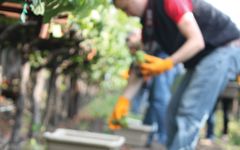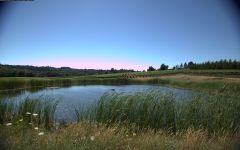Schramsberg Brut Rose 2007
-
Connoisseurs'
Guide -
Wine
Enthusiast -
Robert
Parker -
Wine
Spectator


Product Details
Your Rating
Somm Note
Winemaker Notes
Blend: 71% Chardonnay, 29% Pinot Noir
Professional Ratings
-
Connoisseurs' Guide
Seamlessly combining the cherry-like fruit and vinosity of Pinot Noir with an absolute wealth of autolyzed yeast and very clear in its grasp of what a serious Rosé should be, the latest J. Schram version is a fascinating wine of extraordinary layering, depth and polish. It is explosively bubbled and its very fine mousse lasts and lasts, and, while showing a bit of finishing grip that indelibly marks it is as a true Rosé, its altogether remarkable sense of refinement puts it in a class all its own.
-
Wine Enthusiast
With a pretty pink-salmon color, this Pinot Noir-based blush is rich and full-bodied. It has considerable weight for a bubbly, but the acidity and freshness and yeasty tang lift it up to Champagne elegance. Impossible not to fall in love with this raspberry-scented beauty, but why wouldn’t you want to?
-
Robert Parker's Wine Advocate
A sensational effort, the 2007 Brut Rose (60% Pinot Noir and 40% Chardonnay) offers a beautiful light salmon/pink color as well as a terrific nose of framboise/kirsch and strawberries. The wine hits the palate with freshness, lots of tiny, well-defined bubbles, medium body and a fresh, long finish. This beauty is a top-notch dry rose sparkling wine.
-
Wine Spectator
Boldly structured, yet retains a sense of delicacy, with floral strawberry and spice aromas and full-bodied cherry, vanilla and caramel apple flavors that linger on a festive finish. Drink now through 2014.
Other Vintages
2020-
Wine
Spectator
-
Tasting
Panel -
Wine
Enthusiast -
Wine
Spectator
-
Wine
Spectator -
Robert
Parker -
Wine
Enthusiast -
Connoisseurs'
Guide -
Tasting
Panel
-
Connoisseurs'
Guide -
Wine
Enthusiast
-
Wine
Enthusiast -
Robert
Parker -
Wine
Spectator -
James
Suckling -
Connoisseurs'
Guide
-
Wine
Spectator -
Wine &
Spirits
-
Wilfred
Wong
-
Wine
Spectator -
Wine
Enthusiast -
Connoisseurs'
Guide
-
Robert
Parker -
Tasting
Panel -
Wine
Spectator -
Wine &
Spirits -
Wine
Enthusiast
-
Wilfred
Wong -
Connoisseurs'
Guide -
Wine
Spectator
-
Wine
Spectator -
Tasting
Panel
-
Tasting
Panel
-
Wine
Enthusiast -
Connoisseurs'
Guide -
Wine
Spectator
-
Wine
Enthusiast
-
Connoisseurs'
Guide
-
Connoisseurs'
Guide
-
Wine
Enthusiast
-
Wine
Spectator








In 1965, Jack and Jamie Davies founded Schramsberg and set out to make world-class sparkling wine in the true méthode traditionelle style on the property originally established in 1862 by German immigrant Jacob Schram. There were only 22 bonded wineries in Napa Valley and fewer than 100 acres of California vineyards planted to Chardonnay and Pinot Noir. Schramsberg was the first California winery to provide a Blanc de Blancs in 1965 followed by a Blanc de Noirs in 1967. Now their son, Hugh Davies, leads the winery’s management and winemaking team.
The Schramsberg estate in Napa Valley’s famed Diamond Mountain District is a registered historic landmark with Napa’s first caves, hand-dug in the 1880s, and its first hillside vineyards. Quality focus drives all aspects of wine production starting with access to over 120 cool-climate sites in Carneros, Marin, Mendocino and Sonoma, which result in over 200 separate lots. Unique among California sparkling wine houses, Schramsberg ferments about 25 percent of its juice in oak barrels to produce rich, flavorful, complex wines.
Most of Schramsberg’s viticultural and winemaking practices are carried out by hand: grapes are hand harvested, the wines are handcrafted, and the bottles are stacked and riddled in underground caves. The family and the winery embody excellence and innovation in winemaking, as well as preservation of their land, their history and their community.

What are the different types of sparkling rosé wine?
Rosé sparkling wines like Champagne, Prosecco, Cava, and others make a fun and festive alternative to regular bubbles—but don’t snub these as not as important as their clear counterparts. Rosé Champagnes (i.e., those coming from the Champagne region of France) are made in the same basic way as regular Champagne, from the same grapes and the same region. Most other regions where sparkling wine is produced, and where red grape varieties also grow, also make a rosé version.
How is sparkling rosé wine made?
There are two main methods to make rosé sparkling wine. Typically, either white wine is blended with red wine to make a rosé base wine, or only red grapes are used but spend a short period of time on their skins (maceration) to make rosé colored juice before pressing and fermentation. In either case the base wine goes through a second fermentation (the one that makes the bubbles) through any of the various sparkling wine making methods.
What gives rosé Champagne and sparkling wine their color and bubbles?
The bubbles in sparkling wine are formed when the base wine undergoes a secondary fermentation, which traps carbon dioxide inside the bottle or fermentation vessel. During this stage, the yeast cells can absorb some of the wine’s color but for the most part, the pink hue remains.
How do you serve rosé sparkling wine?
Treat rosé sparkling wine as you would treat any Champagne, Prosecco, Cava, and other sparkling wine of comparable quality. For storing in any long-term sense, these should be kept at cellar temperature, about 55F. For serving, cool to about 40F to 50F. As for drinking, the best glasses have a stem and a flute or tulip shape to allow the bead (bubbles) and beautiful rosé hue to show.
How long do rosé Champagne and sparkling wine last?
Most rosé versions of Prosecco, Champagne, Cava or others around the “$20 and under” price point are intended for early consumption. Those made using the traditional method with extended cellar time before release (e.g., Champagne or Crémant) can typically improve with age. If you are unsure, definitely consult a wine professional for guidance.

One of the world's most highly regarded regions for wine production as well as tourism, the Napa Valley was responsible for bringing worldwide recognition to California winemaking. In the 1960s, a few key wine families settled the area and hedged their bets on the valley's world-class winemaking potential—and they were right.
The Napa wine industry really took off in the 1980s, when producers scooped up vineyard lands and planted vines throughout the county. A number of wineries emerged, and today Napa is home to hundreds of producers ranging from boutique to corporate. Cabernet Sauvignon is definitely the grape of choice here, with many winemakers also focusing on Bordeaux blends. White wines from Napa Valley are usually Chardonnay and Sauvignon Blanc.
Within the Napa Valley lie many smaller sub-AVAs that claim specific wine characteristics based on situation, slope and soil. Farthest south and coolest from the influence of the San Pablo Bay is Carneros, followed by Coombsville to its northeast and then Yountville, Oakville and Rutherford. Above those are the warm St. Helena and the valley's newest and hottest AVA, Calistoga. These areas follow the valley floor and are known generally for creating rich, dense, complex and smooth red wines with good aging potential. The mountain sub appellations, nestled on the slopes overlooking the valley AVAs, include Stags Leap District, Atlas Peak, Chiles Valley (farther east), Howell Mountain, Mt. Veeder, Spring Mountain District and Diamond Mountain District. Napa Valley wines from the mountain regions are often more structured and firm, benefiting from a lot of time in the bottle to evolve and soften.
